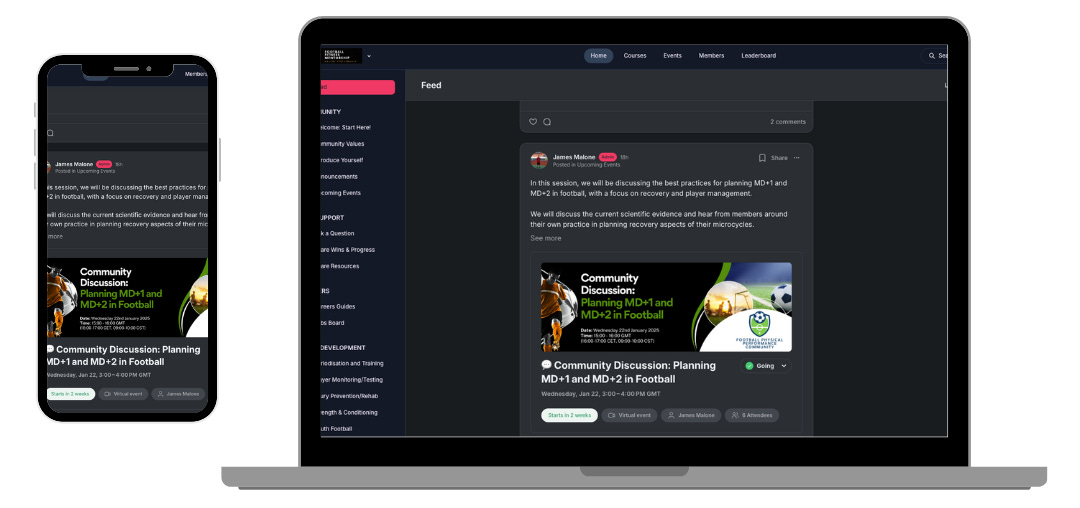“If it doesn’t involve the ball, it’s not football.”
It’s a line I’ve heard many times.
Usually from coaches who are deeply embedded in the tactical and technical side of the game. And to be fair, there’s some logic to it.
But when it comes to developing physical qualities, is that mindset always helpful?
The Debate
Football coaches often prefer to keep players engaged with the ball, and it makes sense.
After all, football is a skill-based game, and keeping drills contextual can improve decision-making, motivation, and perceived relevance.
But sport scientists and physical coaches are often aiming for control: consistent exposure to high-speed running, progressive overload, repeat sprint ability, or force development, which aren’t always achievable through small-sided games or tactical drills.
The friction isn’t about ego - it’s about outcomes. Football coaches want their players sharp and match-fit. Physical staff want players available and robust. The challenge lies in how we get there.
What the Research Tells Us
Small-sided games (SSGs) are often praised for their specificity, but they rarely provide sufficient high-speed running or sprint exposure.
They’re great for aerobic conditioning and technical-tactical work - but not for preparing hamstrings for repeated maximal outputs.
Conversely, isolated running drills (tempo runs, MAS intervals, sprint top-ups) can target specific capacities but they lack decision-making and technical execution. In isolation, neither approach is perfect.
A systematic review with meta-analysis by Clemente et al. (2021) found that SSGs generally under-load sprint and high-speed running compared to match demands. That matters, especially if you're trying to reduce soft-tissue injury risk or build repeat sprint ability.
Multiple studies, such as Malone et al. (2018), show that high-speed running and maximal sprint exposure are not only essential for performance but also for injury prevention.
However, most football-based drills fail to replicate match-level sprint exposure unless space and intent are explicitly designed for it.
Tactical drills (5v5, 8v8, shape work) rarely elicit efforts >90% max velocity. Without deliberate top-ups, this leaves a robustness gap - particularly for hamstring injury prevention.
Football-based drills (especially large-sided games and continuous possession exercises) do develop aerobic capacity, but intensity varies by player position, drill structure, and game rules.
Hill-Haas et al. (2011) showed that coaches must manipulate pitch size, work:rest ratio, and rules very intentionally to reach target heart rate zones.
Blending Both Approaches
In the real world, we don’t have to choose one or the other. We can blend both.
Start the microcycle with integrated football-based drills to engage players and cover aerobic or acceleration demands. Then, finish those sessions with isolated sprint top-ups or position-specific runs to hit high-speed targets as required (using live feedback via GPS and heart rate).
With non-starters, use structured repeat sprint or MAS work to build physical capacity in conjunction with football-specific drills (e.g. SSGs).
Remember to reverse engineer the demands of football. Ask yourself:
What are the physical outputs needed?
High-speed? Repeats? Max sprint?
Design drills (football-based or otherwise) to hit those demands.
The Bottom Line
There is an argument from coaches that sport scientists often “chase the numbers”.
Whilst there can be some truth in this, we should be chasing adaptation not numbers.
In ideal world, you would get all your physical adaptation through football-specific drills. But the research and real world data doesn’t support that notion.
So rather than taking sides in this debate, be open to a hybrid approach that best protects players and gives them the optimal chance to perform on match day.
That's all for today.
See you next Friday.
James 🫡
🚀 Join The Football Performance Network
Take your career in football to the next level by joining a global community of 60+ physical performance practitioners.
As a member, you'll get:
✅ Direct 1:1 mentorship
✅ Weekly live events with industry-leading experts
✅ Practical, high-quality educational content
✅ A supportive network that understands your journey
Whether you're looking to grow your skills, make better decisions in your role, or build your career in elite football, this is the place to do it.
🔗 Join now and start learning, connecting, and progressing — together.





Very interesting article, as it is always a conversation with Physical Coaches - eg " We must do the road running to build an aerobic base.." etc..
Also to consider is a pyramid approach, considering at youth development at younger ages, the best approach is Small Sided Games, and maybe introduce more " isolated" events as they progress through the age groups.